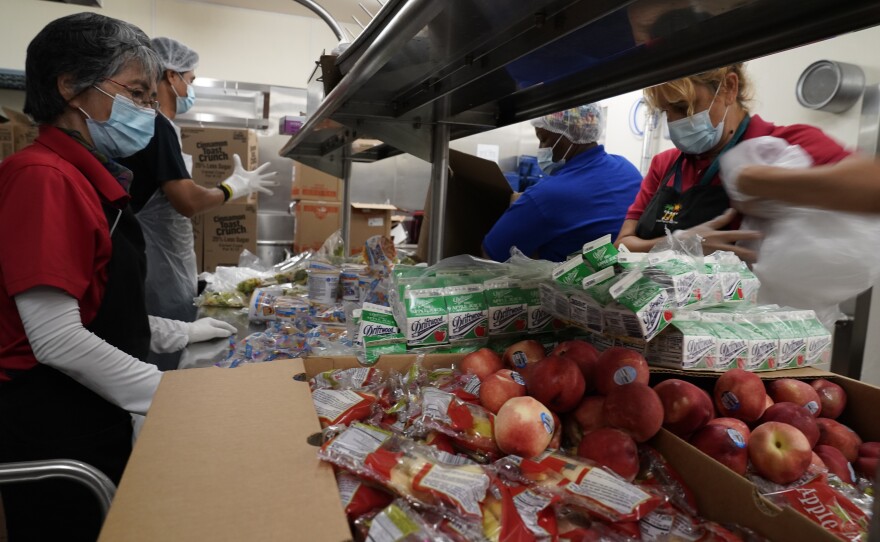It’s lunch time at Lincoln Crossing Elementary. And today, they’re serving up burgers.
But this meal might be a little different than what you’d expect out of a school lunch.
“We have our grass-fed beef,” says Christina Lawson, the food service director for the Western Placer Unified School District. “We have our organic cheddar cheese from Rumiano, which is a producer up in Northern California. We have our local buns that are made by Dos Pisano’s, which is made out of the Bay Area.”
Lincoln Crossing Elementary has been working with the nonprofit Eat Real to phase out ultra-processed foods from school meals since 2023. Lawson says this school could offer an example of what school meals throughout the state could soon look like.
“We're looking at really kind of changing the stigma of what school meals are,” she says.
A new California law, kicking in next January, requires the phaseout of certain ultra-processed foods from school meals throughout the state. Some characteristics the law considers when targeting foods to remove or replace include high levels of saturated fat, sugar and sodium, alongside a host of other ingredients like non-nutritive sweeteners, color additives and thickeners.
These foods have attracted mainstream attention in recent years, especially as the federal administration’s Make America Healthy Again campaign has named eliminating them a key issue. U.S. Health and Human Services Secretary Robert F. Kennedy Jr. went so far as to describe these foods as "poison."
But while federal officials have expressed interest in creating a standard definition for ultra-processed foods, it hasn’t happened yet. This law marks the first in the country to give that phrase a statutory definition.
“We felt a lot of pressure to get it right,” says Democratic Assemblymember Jesse Gabriel, who represents much of the western San Fernando Valley and authored the bill behind the new law. “It's basically what the advocates and scientists said to us — science has taken us as far as they can go when it comes to defining ultraprocessed foods, but to have a workable legal definition, this is where we need policymakers to step in.”
What is an “ultra-processed food”?
Eat Real’s CEO Nora LaTorre says ultra-processed foods — like soda, for example — have been linked to health issues like chronic kidney and liver disease. Her goal is to replace those ultra-processed foods with what she calls more nutrient-dense “real food.”
“Real food is the closest to how Mother Nature intended,” LaTorre says. “The longer the packaging ingredient list, the more processing it is.”
That’s a pretty typical way to guess if a food qualifies as ultra-processed or not. But the phrase doesn’t actually have one, concrete definition — at least, not one that’s universally accepted.
Charlotte Biltekoff, a food and culture expert with UC Davis, says there’s always going to be some disagreement about that.
“Disagreement happens for lots of reasons, but in part, it happens because people have different points of view, different assumptions, different world views and different vested interests,” Biltekoff says. “And so, the disagreement doesn't just happen because the facts are unclear. It happens because people have different motives and aims.”
She says the term “ultra-processed foods” originally comes from a 2009 Brazilian report that created a classification system called NOVA. The system organizes food into groups, from least to most processed.
Biltekoff says it offers a way to understand health and food beyond basic nutritional facts.
“NOVA classification is centrally focused on the amount and kind of processing that a food undergoes as a means of determining its quality,” she says. “So, this is actually a really revolutionary way of thinking about good food, and it really challenged the established paradigms.”
Facing a new choice
Biltekoff says NOVA was meant to be a tool for researching the connection between the degree of processing and health, which could ultimately lead to creating policy. But, despite the popularity of conversations around eliminating ultra-processed foods, actually creating laws around addressing them can be controversial.
“I think a real uptake of an ultra-processed food classification is very disruptive to business as usual,” Biltekoff says.
Gabriel says he knew the new law would have impacts beyond California schools. It’d also affect the companies producing food for students that don’t meet the law’s new guidelines. Inevitably, he says those businesses will have to face a choice.
“If they want to continue to sell in [California], then they need to reformulate their product and make modifications so that it wouldn't include harmful additives and be considered an ultra-processed food of concern,” Gabriel says. “We think it’s going to put some extra pressure on manufacturers to do the right thing.”
As the law was discussed in the legislature, it got pushback from a coalition of agricultural producers and food manufacturers. Some were concerned about costs associated with adjusting food items around the law. Others worried it could inadvertently include foods that shouldn’t be banned — like foods that use natural additives like beet juice to enhance the color of a food, for example.
Gabriel says part of creating the law meant narrowing the definition enough to avoid unintended consequences.
“We took amendments, for example, to exempt natural seasonings and natural colorants,” he says. “So, just kind of working around the edges on some of the nuances there to make sure we had a really strong definition … but one that we also could implement and that would work for all of the diverse stakeholders.”
The law requires schools to phase out ultraprocessed foods of concern no later than July 2029. It also bans vendors from offering these foods to schools starting in July 2032. Gabriel says he’s expecting to see concrete progress at schools toward phasing these foods out within the next couple of years.
But a menu makeover requires investment. At Lincoln Crossing Elementary, that included new equipment for the kitchen and more staff training.
Those efforts brought the school to where it is today, with more than half the meals served being freshly prepared. It’s a big jump from where the school started in the 2022-2023 school year, when only around 5% were freshly prepared with the rest of the meals being primarily heat and serve.
But serving the food is only one part of the equation. Lawson says the key ingredient in this transformation is making sure students actually want to eat the food. That’s why she leads regular surveys with students to review new menu items.
“We want them to like it,” she says. “We want them to enjoy the meal. We want it to actually taste good.”






